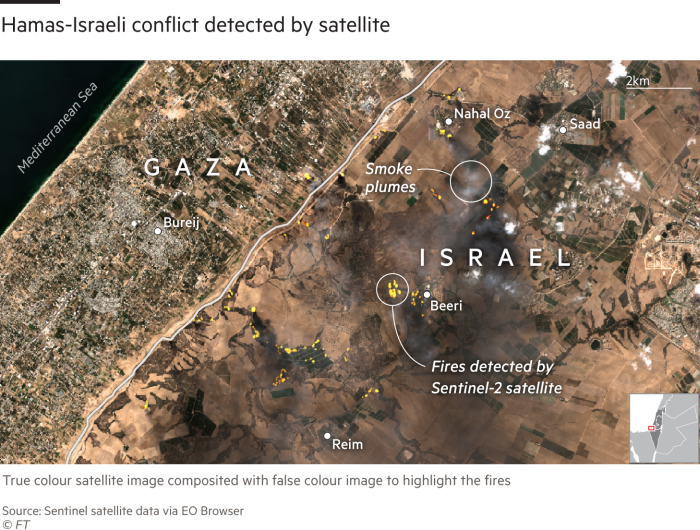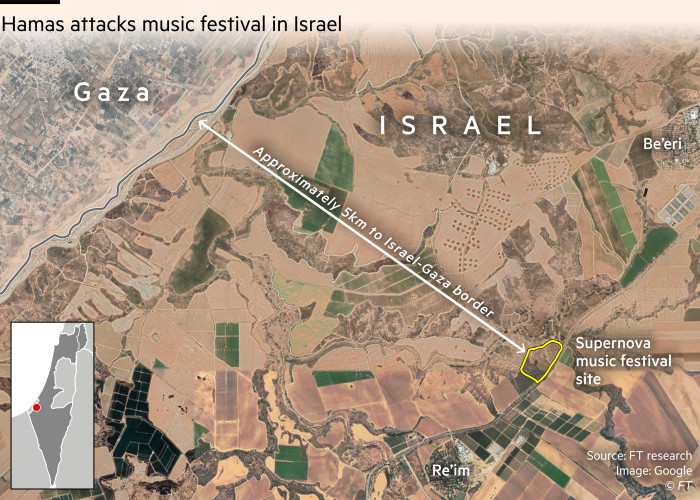Unlock the Editor’s Digest for free
Roula Khalaf, Editor of the FT, selects her favourite stories in this weekly newsletter.
-
Latest situation: Netanyahu dissolves Israel’s war cabinet
-
Impact on population: Death toll in Gaza tops 37,000; over 100 hostages in captivity
-
Food and water insecurity: Aid deliveries slump after IDF seizure of Rafah crossing
-
Infrastructure damage: More than half of Gaza’s buildings damaged by fighting
-
Key events in the war: From Hamas’s October 7 attack to Israel’s incursion
Latest situation: Netanyahu dissolves Israel’s war cabinet
Israeli Prime Minister Benjamin Netanyahu dissolved the country’s war cabinet on Monday following the resignation of two of its five members.
The group has overseen Israel’s war in Gaza for the past eight months. According to Israeli officials, Netanyahu will now hold meetings in smaller forums to discuss sensitive matters. The country’s wider security cabinet, will also continue to deal with matters relating to the war, officials said.
The arrangement was designed to sideline more radical elements of Netanyahu’s coalition, which have repeatedly demanded a more aggressive approach to the war as well as the re-establishment of Israeli settlements in the Palestinian enclave.

Impact on population: Death toll in Gaza tops 37,000; over 100 hostages in captivity
The Israel Defense Forces launched air and land offensives in Gaza in response to Hamas’s October 7 cross-border assault in southern Israel.
Hamas killed more than 1,200 people during the attack and seized about 250 hostages, according to Israeli officials, who say 120 hostages are still in captivity.
More than 37,000 people have been killed during the Israeli assault on Gaza, according to Palestinian officials.
Humanitarian workers inside Gaza have also faced significant danger during the conflict, with an unprecedented number being killed.
Seven international aid workers were killed in an April strike, with Israel later admitting that its soldiers had made errors in targeting the humanitarian convoy. More than 200 employees of UNRWA, a UN agency that provides aid and support to Palestinians, have also been killed.
After October 7, the IDF initially moved into northern Gaza before sweeping south towards Khan Younis and then Rafah. On May 24 the International Court of Justice said conditions in Rafah were “disastrous” and ordered Israel to “immediately halt” its military offensive in the city.
More than 2mn people in Gaza have been displaced by the conflict, with many leaving Rafah and some moving to al-Mawasi or other IDF-declared “humanitarian areas”, while others head north towards the cities of Khan Younis and Deir al Balah.

Food and water insecurity: Aid deliveries slump after IDF seizure of Rafah crossing
Aid deliveries containing urgently needed food, water and medical supplies have not been able to enter Gaza at their usual levels since the war began.
The shortages have worsened since IDF troops took “operational control” of the Palestinian side of the Rafah crossing on May 6.
The struggle to access food aid, which is urgently needed to prevent Gazans slipping into famine, is forecast to have reached “catastrophic” levels.
The US has built a $320mn floating pier to help get more aid into Gaza, but shipments have been affected by storms and poor sea conditions.
The endeavour has drawn criticism from aid groups who say it is costly and limited in capacity, compared with more efficient land routes that have frequently been impeded by Israeli restrictions and far-right protests.

Since Israel launched its Gaza offensive, damage to infrastructure and lack of fuel and electricity have also led to a severe water shortage.
Before the war, Gaza sourced most of its water from an underground aquifer or Israeli state-owned water company Mekorot. According to an April UN OCHA report, two of the Mekorot pipelines have been closed and the third is operating at only partial capacity. Israel has recently moved towards reopening them after pressure from the US.
Meanwhile, only one of the six wastewater treatment plants and two of three desalination plants are partially working.

Infrastructure damage: More than half of Gaza’s buildings damaged by fighting
According to damage assessments from researchers at the CUNY Graduate Center and Oregon State University, more than half of all buildings across the Gaza Strip have suffered damage, rising to nearly 80 per cent in Gaza City.
The damage in Khan Younis and Rafah has also increased as Israel expanded its offensive from northern Gaza to the rest of the territory.

October 9 2023 to present: Key events in the war
June 10 2024
Biden’s Gaza ceasefire plan endorsed by UN Security Council
June 9 2024
Israel rescues four hostages in Gaza but scores of Palestinians killed
June 6 2024
Dozens killed in Israeli strike on UN school in Gaza
May 24 2024
ICJ orders Israel to halt Rafah offensive
May 20 2024
ICC prosecutor requests arrest warrants for Israeli Prime Minister Benjamin Netanyahu and senior Hamas leaders over alleged war crimes
May 7 2024
Israel sends troops into Rafah and seizes border crossing despite Hamas agreeing to ceasefire-for-hostage deal
April 19 2024
Israel launches calibrated retaliatory strikes against Iran
April 14 2024
Iran launches drones and missiles at Israel in response to Israeli air strike on Iran’s Damascus embassy
April 5 2024
Israel admits “grave mistake” after strike on World Central Kitchen aid workers
March 25 2024
UN resolution demands Gaza ceasefire
February 29 2024
More than 110 Gazans killed in deadly aid convoy chaos
December 4 2023
Israel steps up aerial bombardment on southern Gaza followed later in the month by an offensive into the city of Khan Younis
November 24 2023
Israel-Hamas truce takes hold ahead of planned hostage release
November 16 2023
Israeli military raids Gaza’s largest hospital in climax of siege
OCTOBER 9 2023
Israel imposes a “complete siege” on Gaza, calling up a record 300,000 reservists and pounding the strip from the air
October 7 2023: Hamas attacks Israel
As much of Israel slept, Hamas militants launched an multipronged dawn assault on the country from the Gaza Strip.
The assault began in the early hours of the morning on the Jewish holiday of Simchat Torah, with thousands of rockets fired at Israeli towns and cities. Many were intercepted by Israel’s Iron Dome defence system, but satellite imagery showed fires and smoke rising from locations that were hit.

Hundreds of Hamas fighters simultaneously attacked by land, air and sea, breaching the fortified barrier between Gaza and Israel.
Militants used motorised paragliders to attack the Supernova music festival, which was taking place not far from the Gaza border. After flying in, they shot many Israelis and took others as hostages.

After breaching the Gaza fence, armed Hamas fighters targeted Israeli communities and military sites at several locations, going door-to-door and performing execution-style killings as well as taking hostages.
More than 1,200 Israeli civilians and troops were killed on October 7, according to Israeli officials — making it the deadliest attack on the country since its foundation.
Visual and Data team: Aditi Bhandari, Jana Tauschinski, Janina Conboye, Peter Andringa, Steven Bernard, Chris Campbell, Sam Joiner, Lucy Rodgers, Ian Bott, Dan Clark and Alan Smith
Read More: World News | Entertainment News | Celeb News
FT
















